Euphorbia amygdaloides ‘Purpurea’
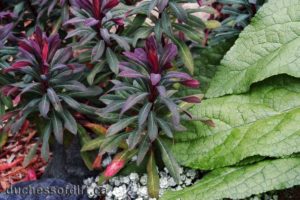 Euphorbia amygdaloides ‘Purpurea’
Euphorbia amygdaloides ‘Purpurea’
(yew-FOR-bee-ah ah-mig-dah-LOY-deez
per-per-EE-ah)
syn. Euphorbia amygdaloides ‘Rubra’
Family: Euphorbiacaea
Common name: wood spurge; purple wood spurge
Zone: 5 – 9
Height: 12 – 18 in (30 – 45cm)
Spread: 12 in (30cm)
Aspect: full sun; partial shade; full shade
Soil: average; well-draining
Water: minimal
 Description: An evergreen perennial with an upright, bushy habit. Stems and lanceolate leaves are a handsome burgundy-purple colour which show off the clusters of bright greenish-yellow flower bracts to perfection in mid-spring through early summer. Foliage changes to purple-black in winter.
Description: An evergreen perennial with an upright, bushy habit. Stems and lanceolate leaves are a handsome burgundy-purple colour which show off the clusters of bright greenish-yellow flower bracts to perfection in mid-spring through early summer. Foliage changes to purple-black in winter.
Special Notes: Flowers on old wood. Prune plants back after flowering. Good cut flower but stem tips must be singed or dipped in boiling water to stop the milky sap from flowing.
Drought tolerant. Deer and rabbit resistant but may be susceptible to aphids. Watch for powdery mildew or grey moulds which would indicate too much moisture or poor air circulation. Propagate by seed or by division in spring or autumn.
Caution: Potential to become a nuisance if spent flowers are not removed before seeds mature or by regularly dividing the plant every few years to keep the rhizomes from spreading beyond the boundary you set for this lovely plant.
Milky sap can cause skin and eye irritation. Toxic if ingested. Wear gloves when handling. Protective eye equipment is recommended.
In our Zone 7a garden: We find this plant quietly adds its charm to the garden display with a minimum of fuss and bother.
The Duke of Compost adds: Be sure to water this plant regularly during heat waves, especially if you have placed it in full sun. It is only drought tolerant up to a point.
Posted on March 7, 2013; updated on April 22, 2025
Epimeduim x versicolor ‘Sulphureum’
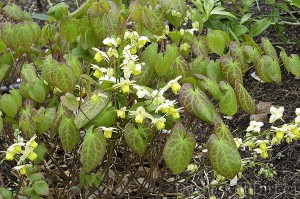 Epimedium x versicolor ‘Sulphureum’
Epimedium x versicolor ‘Sulphureum’
(ep-ih-MEE-dee-um x VUR-sih-kull-ur)
Family: Berberidacaea
Common name: yellow barrenwort; yellow bishop’s hat
Zone: 5 – 9
Height: 12 – 15 in (30 – 38cm)
Spread: 12 in (30cm)
Aspect: partial shade; full shade
Soil: fertile; humus-rich; well-draining
Water: moderate
Description: An evergreen perennial with a mounding, slow spreading habit. Pale yellow, bishop hat-shaped flowers appear at the top of spurs in mid- through late spring. Heart-shaped, dark green leaflets are flushed a deep bronze-red colour when they first appear during the flowering period, gradually losing this flush as the season progresses. Leaves form a very pleasing evergreen mound.
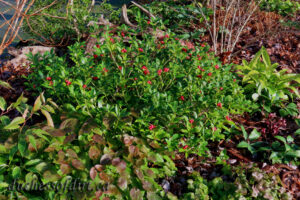 Special Notes: Hybrid seedling of E. grandiflorum x E. pinnatum subsp. cochicum. This plant is valued for its ability to thrive and prosper amongst the tough roots of mature trees. Needs fertile soil and regular watering during the hot summer periods when planted in full sun. Flower production will not be as vigorous and winter foliage colour will be compromised if planted in full shade. Cut leaves back in early February to view the flowers and allow for fresh new growth. Fresh plant divisions will take up to two years to establish. Propagate by division in autumn.
Special Notes: Hybrid seedling of E. grandiflorum x E. pinnatum subsp. cochicum. This plant is valued for its ability to thrive and prosper amongst the tough roots of mature trees. Needs fertile soil and regular watering during the hot summer periods when planted in full sun. Flower production will not be as vigorous and winter foliage colour will be compromised if planted in full shade. Cut leaves back in early February to view the flowers and allow for fresh new growth. Fresh plant divisions will take up to two years to establish. Propagate by division in autumn.
Royal Horticultural Society Award of Garden Merit (AGM) 1993
Posted on March 7, 2013; updated on April 2, 2025
Epimedium x rubrum
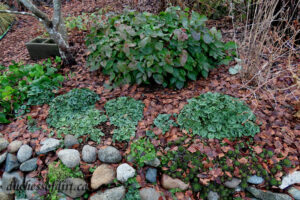 Epimedium x rubrum
Epimedium x rubrum
(ep-ih-MEE-dee-um x ROO-brum)
Family: Berberidacaea
Common name: red barrenwort; red bishop’s hat; fairy wings
Zone: 5 – 9
Height: 12 – 15 in (18 – 38 cm)
Spread: 12 – 24 in (18 – 60 cm)
Aspect: partial to full shade
Soil: fertile; humusy; well-draining
Water: moderate
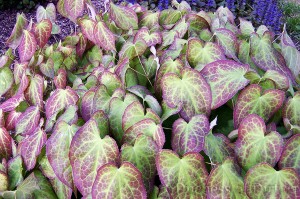 Description: A semi-evergreen perennial with a mounding, slowly spreading habit. Red, bishop hat-shaped flowers appear at the top of spurs in mid- through late spring. Heart-shaped, dark green leaflets are flushed a deep bronze-red colour when they first appear during the flowering period, gradually losing the red flush as the season progresses. Leaves form a very pleasing evergreen mound.
Description: A semi-evergreen perennial with a mounding, slowly spreading habit. Red, bishop hat-shaped flowers appear at the top of spurs in mid- through late spring. Heart-shaped, dark green leaflets are flushed a deep bronze-red colour when they first appear during the flowering period, gradually losing the red flush as the season progresses. Leaves form a very pleasing evergreen mound.
Special Notes: Hybrid seedling from E. alpinum and E. grandiflorum. This plant is valued for its ability to thrive and prosper amongst the tough roots of mature trees. Cut the leaves back in late winter in order to view the fresh flush of flowers and allow for fresh new foliage growth to develop. Fresh plant divisions will take up to two years to settle in. Propagate by division in autumn. Good pest and disease resistance. Deer and rabbit resistant.
In our Zone 7a garden: We have found this plant does well in mediocre soil and deep shade, holding its own against tree and shrub roots…although a top dressing of soil amendment in early spring keeps our plants flourishing nicely. Nothing seems to affect this plant species with the exception of an occasional problem with leaf cutter bees taking small, crescent moon-shaped cuts out of some leaf edges.
Royal Horticultural Society Award of Garden Merit (AGM) 1993; Great Plant Pick 2005
Posted on March 7. 2013; updated April 2, 2025
Eranthis hyemalis
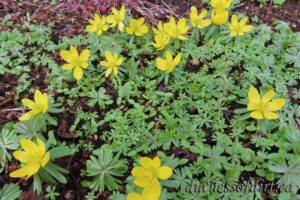 Eranthis hyemalis
Eranthis hyemalis
(air-AN-thiss hye-em-AY-liss)
syn. Aconitum hyemale
Family: Ranunculaceae
Common name: winter aconite; winter hellebore
Zone: 4 – 9
Height: 4 – 6 in (10 – 15 cm)
Spread: 4 in (10 cm)
Aspect: sun; partial shade
Soil: fertile, humus-rich; well-draining
Water: moderate
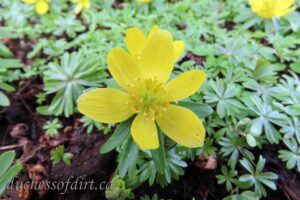 Description: A spring-flowering, low growing, herbaceous, tuberous perennial. Rich green-coloured, palmately lobed basal leaves form a rosette on top of the soil. Each upright stem supports a bright yellow, cupped flower cradled on a collar of deeply lobed stem leaves. Flowers have a sweet, honey scent. It is a spring ephermeral…with leaves emerging in late January, setting flowers with seed pods following. The whole process taking a mere two to three months before the plant disappears below ground again to rebuild its strength for a beautiful floral display again the following winter.
Description: A spring-flowering, low growing, herbaceous, tuberous perennial. Rich green-coloured, palmately lobed basal leaves form a rosette on top of the soil. Each upright stem supports a bright yellow, cupped flower cradled on a collar of deeply lobed stem leaves. Flowers have a sweet, honey scent. It is a spring ephermeral…with leaves emerging in late January, setting flowers with seed pods following. The whole process taking a mere two to three months before the plant disappears below ground again to rebuild its strength for a beautiful floral display again the following winter.
Special Notes: Native to southern Europe from Italy to Bulgaria, and including Turkey. Has naturalized outside of its native boundaries. Introduced into English gardens around 1596, it has since spread to establish naturalized colonies in the wild in that country.
Eranthis hyemalis is a winter hardy understory plant, preferring placement under deciduous trees whose bare branches allow sunlight to reach the ground throughout the winter months.
This plant is non-aggressive…it does not run rampant through the garden. Indeed, many gardeners bemoan the fact their golden patch of winter aconites does not increase. Propagation is by fresh seed…either by allowing the plants to form seed pods and self-scatter, or buying very fresh seed from a reliable source and immediately sowing them. Germination time is long, and needs winter stratification temperatures to break dormancy. Cleaning up the garden bed or walking on the soil are two main reasons why Eranthis spp. are difficult to grow.
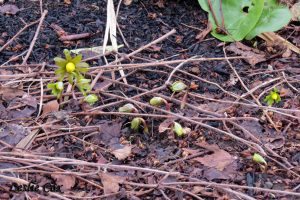 If you have already established a patch of Eranthis in your garden, you can start a patch in another area of the landscape by carefully digging up a few plants…after flowering but before the green leaves disappear underground. Be sure to provide some compost as this genus loves humus.
If you have already established a patch of Eranthis in your garden, you can start a patch in another area of the landscape by carefully digging up a few plants…after flowering but before the green leaves disappear underground. Be sure to provide some compost as this genus loves humus.
If you purchase tubers from a nursery, buy as fresh as you can. Dried out tubers usually do not produce plants…although some gardeners have had limited success by soaking dried tubers before planting.
Deer, rabbit, and squirrel resistant. Not many disease problems, although smut…black spots appearing on leaves, caused by a fungus in the genus Urocystis…can be devastating. It is best to carefully dig up the infected plant and place it in the garbage…before the black spores are released to infect other plants in the colony.
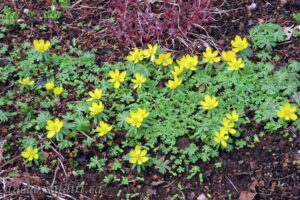 In our zone 7a garden: We started our patch of Eranthis hyemalis sometime around 2006 or 2007 from fresh seed gathered from a neighbour’s plants. The seeds were immediately sown underneath the Viburnum opulus ‘Roseum’ where they flourished and multiplied to become a delightful patch. (Sadly, the viburnum had to be removed due to a serious infestation of viburnum leaf beetles. A native Physocarpus opulifolius ‘Monlo’ Diablo® has been planted in its place.)
In our zone 7a garden: We started our patch of Eranthis hyemalis sometime around 2006 or 2007 from fresh seed gathered from a neighbour’s plants. The seeds were immediately sown underneath the Viburnum opulus ‘Roseum’ where they flourished and multiplied to become a delightful patch. (Sadly, the viburnum had to be removed due to a serious infestation of viburnum leaf beetles. A native Physocarpus opulifolius ‘Monlo’ Diablo® has been planted in its place.)
I am very fond of the bright little winter aconite flowers as they are a ray of sunshine bursting forth in the dead of winter…instilling hope that spring is finally on its way.
Caution: All parts of the plant are poisonous…the toxic compounds of note are cardiac glycosides. These are not as toxic as those toxins found in Aconitum spp. but still to be avoided ingesting.
RHS Award of Garden Merit 1993; Great Plant Pick 2012
Posted on February 11, 2017; updated on February 24, 2025
Dodecatheon media
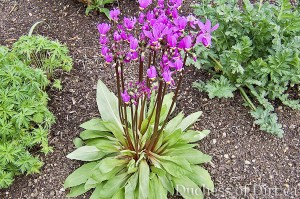 Dodecatheon meadia
Dodecatheon meadia
(doe-duh-KAY-thee-un MEE-dee-uh)
Family: Primulaceae
Common name: shooting star
Zone: 4 – 8
Height: 12 – 20 in (30 – 50 cm)
Spread: 10 – 12 in (25 – 30 cm)
Aspect: full sun; part shade; full shade
Soil: moist, fertile, well-draining
Water: moderate
Description: An herbaceous perennial with pale green, lance-shaped leaves which form an upright rosette. As many as four leafless flower stalks emerge from the centre of the rosette, arising to a height of up to 20 inches (50 cm). Each flower stalk has an umbel on top with as many as twenty nodding, lightly fragrant flowers dangling from their individual stems. Each 1 inch (2.5 cm) long flower has 5 reflexed petals. Colour can be variable, ranging from white to pink to lavender purple. A cluster of bright yellow stamens is noticeable below the petals for its pointed formation. The whole floral effect gives the appearance of a bunch of shooting stars plummeting to earth. Bloom time is mid- to late spring…April through May. A seed capsule containing small dark seeds forms on top of the stalk after flower petals die back.
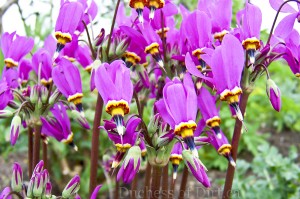 Special Notes: Native to North America…more commonly on the east coast and into the central prairies, but also found in the Pacific Northwest. Typically, this plant is found growing naturally in glades, deciduous forests, treed rock slopes, ledges, and meadows. It is tolerant of most soil types…preferring rich, moist, well-draining soil, but also clay-type as long as drainage is decent. Does not like poorly drained, wet soils, especially in winter. Due to its early bloom time, it is an important foraging plant for queen bumblebees. The whole plant goes dormant in summer, reappearing the following spring.
Special Notes: Native to North America…more commonly on the east coast and into the central prairies, but also found in the Pacific Northwest. Typically, this plant is found growing naturally in glades, deciduous forests, treed rock slopes, ledges, and meadows. It is tolerant of most soil types…preferring rich, moist, well-draining soil, but also clay-type as long as drainage is decent. Does not like poorly drained, wet soils, especially in winter. Due to its early bloom time, it is an important foraging plant for queen bumblebees. The whole plant goes dormant in summer, reappearing the following spring.
There are no serious pest or disease problems. Deer resistant.
Slow and difficult to grow from seed. Needs vernalization…exposure to a prolonged period of winter cold…for germination. Easiest method is to allow the plant to self-seed. Alternatively, the seed can be collected in spring, sown in a tray filled with a sterile soil-less potting mix, and placed in a protected shady spot outdoors for the rest of the year. (Make sure the soil is kept slightly damp.) You can also collect the seeds and store them in an envelope or other suitable container, and place them in a cool, dry location. There are a few different methods of germinating collected seeds held indoors. One such method is to place some sterile soil-less potting mix in a ziplock bag, then add some seeds to the mix…making sure they are incorporated into the potting soil. Place the bag in the refrigerator for one day. Next day, place the bag of soil and seeds in the freezer for one day. Repeat this alternating schedule for one week. After stratifying the seeds in this manner, sow them about 0.1 inch (0.3 cm) deep in pots and place on a heating mat set to 20 °C (68 °F). Make sure the pots do not dry out.
Or you can save some of this trouble and simply divide your plant when it is large enough.
In our Zone 7a garden: We have a delightful clump of Dodecatheon meadia under the magnolia tree. Always a pleasure to see it arrive on scene…a true indication spring is really getting underway.
We have allowed this plant to self-seed in place to save the work of germinating seeds ourselves. The plant will be then be divided.
Royal Horticultural Society Award of Garden Merit (AGM) 1993
Posted on April 4, 2018; updated on February 19, 2025
